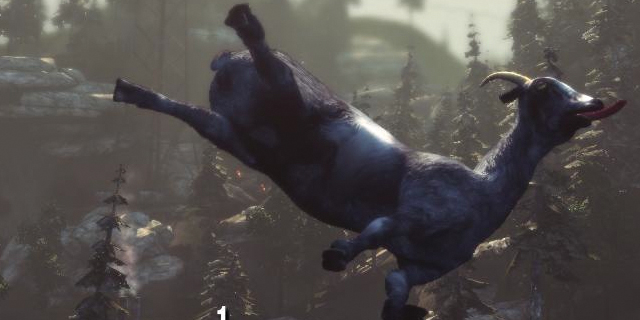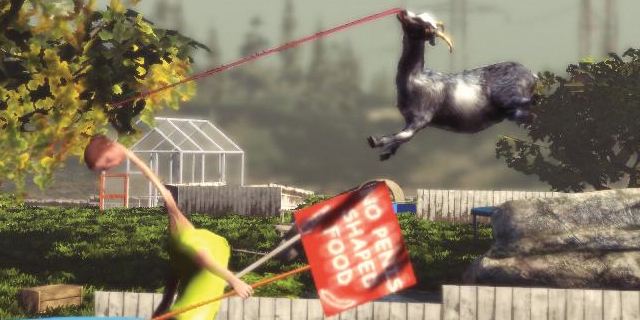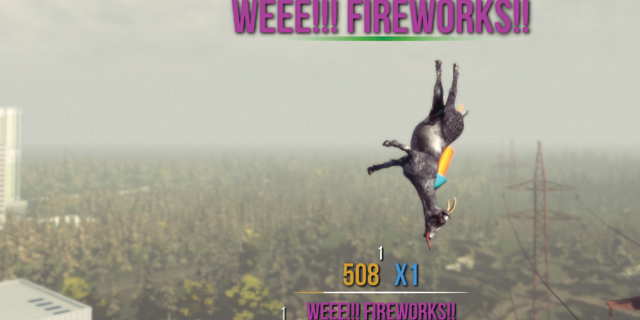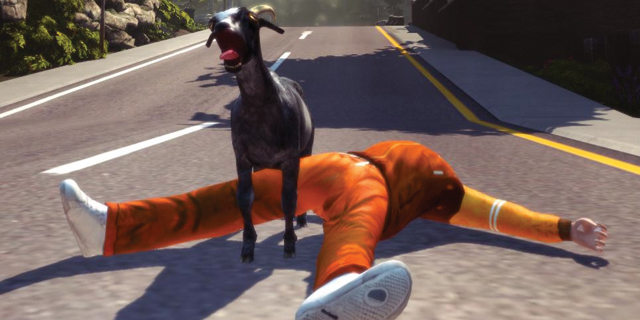
If we expect gaming to grow into its own as a medium to stand among literature, film and music in terms of cultural relevance, we can’t dismiss any work’s artistic merits. If we don’t take our medium seriously, then who will? To that end, I have a hypothesis that some would call downright mad: that Goat Simulator is the most important interactive experience of the year. No, I’m not kidding (no pun intended).
Goat Simulator, released last month, places you in control of a seemingly indestructible goat as you interact with a small sandbox environment. You can jump around the area, drag objects along with your tongue, use your horns to ram things and discover secret powers. There are even dedicated braying buttons, “ragdoll” mode and a slow-motion option. We can learn a lot about a game’s motives from its default control layout, so let’s take a look at which actions are mapped to which buttons.
Two of the face buttons are used for jumping and tongue control, which make sense. More importantly, the other two buttons are used for collapsing your goat like a ragdoll and making it emit a braying noise. Keep that in mind: the face buttons are almost exclusively reserved for a game’s most important functions.
The controls show that this game is one that eschews the standard skill-emphasizing, goal-based model. Unless you count the achievements and scoring system, this is a game with no explicit goals or intrinsic motivations – things such as narrative progression or challenge completion. Goat Simulator deliberately abandons some of the most basic models of engagement in game design. Instead, it wholeheartedly embraces the mentality and core engagements of the sandbox genre, giving us what we really want when playing games like these. Even other sandbox games generally tie the experience together, or at least bookend it, with goals stated in the game for the player to accomplish. Goat Simulator does no such thing.

Goat Simulator also is notable for being intentionally released with myriad glitches and bugs. It doesn’t try to avoid bizarre, unintended consequences of experimentation – it enshrines them. By making a game that is “broken” by any conventional measure, the developers give the player tools to paint outside the lines with, and make a mockery of the strict quality control we expect from games today. This tactic subverts the established tone set by the gaming industry, and dives head-first into the land of the ludicrous, needing to bring nothing more than its mere existence to have meaning. The important takeaway: Goat Simulator aspires to break our conceptions of what we consider to be a worthwhile game.
All of these facts may amount to Goat Simulator being distinctive, perhaps to a fault, but why is it the most important game of the year? First, we need to take a step back and look at all of the different forms of artistic media, and their own journeys toward cultural adoption and relevance. One important trend for most other media is the formation of different artistic principles. In almost every case, development can be traced back to the branching of a medium into different movements and creative ideologies. On the other side of the coin, it is a good sign that a medium is being taken seriously enough to undergo thoughtful critique and questioning.
The development of distinctly varied artistic principles and schools of thought is a healthy part of a medium’s development. Such creative archetypes allow it to more effectively explore new ideas by using several perspectives to view the same concepts. Interactive experiences have yet to adopt these on as formal of a level as literature, visual art (like paintings, drawings and sculptures) and film. However, we have started to see support for the various movements, which is a very promising sign. One artistic movement in particular that feels right at home with Goat Simulator is Dadaism.

Dadaism was an artistic movement born out of the mood of defeatism enshrouding Europe in the aftermath of World War I. The central premise of its adoption was that it had no rules or regard for taste. The only thing that truly defined the movement was a strident and active disregard for traditional artistic norms. Dadaism was an attempt to show that the boundaries defining art up until that point were meaningless, and that radically unconventional and purposefully tasteless works were the most effective means to this end. That is not to say that Dadaist works were unable to stand on their own, but they gained their complete meaning when taken into the context of their cultural environment. I believe that – provided we are not unwaveringly shackled to artistic intent – Dadaism is a good framework for assessing Goat Simulator.
Naturally, we need to separate the specific historical events that originated Dadaism from the thematic ties that bind the principle, giving us a more modern conception of it. Taking that into account, we start to see the potential connections take shape. Goat Simulator was made with the intent of creating a game that is amusing and absurd based on its own broken nature, and giving the player the tools to push said brokenness to the limits. The main extrinsic motivation is seeing just how much you can do with the game that you are not meant to.
In a gaming landscape populated densely by high-spectacle, heavily-scripted and dramatic “cinematic” experiences, it isn’t much of a stretch to say that something like Goat Simulator gets much of its significance by being everything traditional games are not. It gleefully relishes the desecration of gaming norms, as well as itself, and shows its mad brilliance in self-destruction. The game is meant to be offensive by traditional merits – that is what makes it as entertaining as it is.

The game’s minutia even serve to further this end. Goat Simulator‘s scoring system frequently awards points and multipliers for actions that are inconsequential at best, or exclusively unintentional at worst. While the debate over the merits of points as an intrinsic motivator is a much more complicated one best left for another time, it is easy to see that here, the scoring system’s primary goal is to enhance the absurdity. Secondly, the game’s achievements accomplish the same goal, with rewards given for causing the game to crash or getting a high score in “Flappy Goat,” Goat Simulator‘s parodic game-within-a-game. This packs even more of a punch due to the nature of significance surrounding achievements themselves.
Some may argue that because Goat Simulator is entertaining at all, it is disqualified from being classified as Dada. Under the given definition, nearly all comedy would technically be Dada. However, just like other art, comedy still has standards for quality and defines boundaries. Dada exists for the purpose of mocking boundaries, something Goat Simulator succeeds at in the context of modern gaming. That is not to say the game is not intended to be comedic – far from it.
Dada can be comedic by nature alone. The developers may have set out to create a humorous product, and they did indeed do so. But, they more importantly created a deconstruction of the standards we imply upon interactive experiences – more appropriately, the ones that apply to the more tightly-controlled, big-budget titles that prove popular due to their polish.

We need more games like Goat Simulator in today’s gaming landscape, that venture outside the boundaries we have set, so we can look back at them with a critical eye. Games that give us unimaginably different and strange experiences that we would never get in the mainstream market. We rarely see a game execute this as effectively as Goat Simulator. We will never get new experiences if we never experiment with our medium, and take apart our barriers when they prove to be artificial. These kinds of games are more helpful than all of the Call of Duty clones money can buy.



















